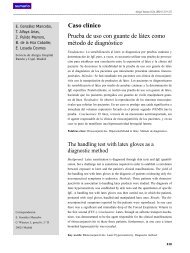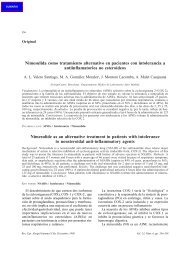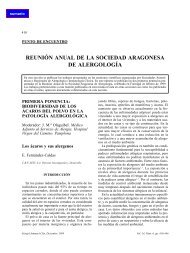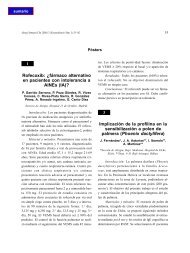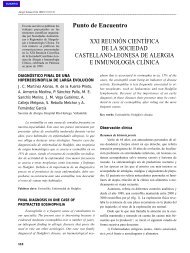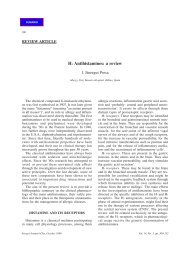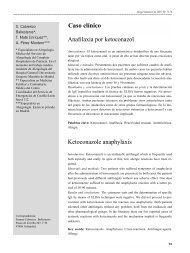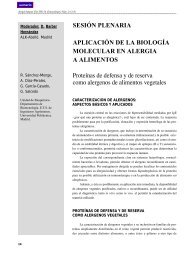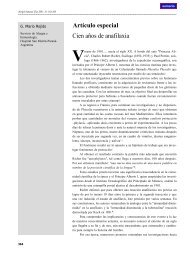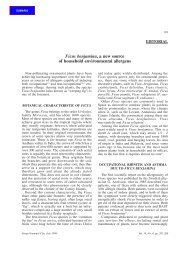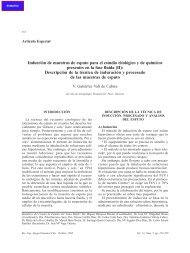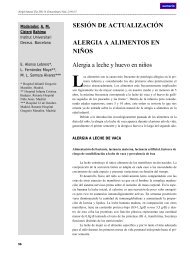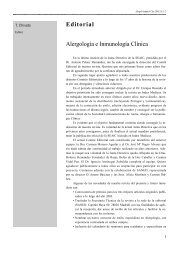Angioedema por déficit de C1-inhibidor - Alergología e Inmunología ...
Angioedema por déficit de C1-inhibidor - Alergología e Inmunología ...
Angioedema por déficit de C1-inhibidor - Alergología e Inmunología ...
You also want an ePaper? Increase the reach of your titles
YUMPU automatically turns print PDFs into web optimized ePapers that Google loves.
ma. El control <strong>de</strong> la enfermedad subyacente se traduce<br />
generalmente en reducción <strong>de</strong> los síntomas <strong>de</strong> e<strong>de</strong>ma 16 .<br />
El tratamiento <strong>de</strong>l angioe<strong>de</strong>ma es igual que la forma<br />
hereditaria, aunque las dosis farmacológicas necesarias<br />
pue<strong>de</strong>n ser mayores y la respuesta clínica menos previsible.<br />
En cuanto a la profilaxis a largo plazo existen variaciones<br />
im<strong>por</strong>tantes individuales, pero el ácido tranexámico<br />
es más eficaz que los andrógenos atenuados, <strong>por</strong> lo<br />
que sería el tratamiento <strong>de</strong> elección 16 .<br />
La administración <strong>de</strong> concentrado <strong>de</strong> <strong>C1</strong>-<strong>inhibidor</strong><br />
en el tratamiento <strong>de</strong> los ataques agudos da también peores<br />
resultados que en la forma hereditaria 13 .<br />
Donaldson y cols. tuvieron que realizar plasmaféresis<br />
seguida <strong>de</strong> tratamiento con ciclofosfamida en un<br />
paciente con autoanticuerpos y afectación muy severa, con<br />
buena evolución. No se <strong>de</strong>tectó enfermedad subyacente 43 .<br />
Para prevenir complicaciones trombóticas en<br />
pacientes <strong>de</strong> riesgo, algunos autores asocian anticoagulantes<br />
orales a dosis bajas 13 .<br />
Peculiarida<strong>de</strong>s <strong>de</strong>l tratamiento en el embarazo. Durante<br />
el embarazo se pue<strong>de</strong> producir un <strong>de</strong>scenso o un agravamiento<br />
<strong>de</strong> la actividad <strong>de</strong>l angioe<strong>de</strong>ma 22,29 . El uso <strong>de</strong> andrógenos<br />
está contraindicado <strong>por</strong> la potencial virilización<br />
<strong>de</strong> un feto femenino 44 . Sería aconsejable planificar los embarazos<br />
y suspen<strong>de</strong>r los andrógenos al menos un mes antes.<br />
En el tratamiento <strong>de</strong> los ataques agudos pue<strong>de</strong> utilizarse<br />
<strong>C1</strong>-<strong>inhibidor</strong> intravenoso 45 . Si la severidad <strong>de</strong> la clínica lo<br />
requiere pue<strong>de</strong> utilizarse antifibrinolíticos como profilaxis a<br />
largo plazo. Generalmente no se requiere el tratamiento<br />
profiláctico en partos no complicados, pero el <strong>C1</strong> <strong>inhibidor</strong><br />
se ha utilizado <strong>de</strong> forma preventiva en cesáreas.<br />
Nuevos tratamientos. Se están <strong>de</strong>sarrollando nuevos<br />
fármacos: <strong>C1</strong>-<strong>inhibidor</strong> recombinante, bloqueantes<br />
<strong>de</strong> bradiquinina y bloqueantes <strong>de</strong> calicreína.<br />
SEGUIMIENTO<br />
Se <strong>de</strong>ben realizar controles anuales que incluyan<br />
enzimas hepáticos, niveles <strong>de</strong> CPK y aldolasa, niveles <strong>de</strong><br />
C3, C4, <strong>C1</strong>-<strong>inhibidor</strong> y serología VHB, VHC y VIH.<br />
Algunos autores proponen que se monitorice la actividad<br />
funcional <strong>de</strong> <strong>C1</strong>-<strong>inhibidor</strong> como seguimiento <strong>de</strong> la eficacia<br />
<strong>de</strong>l tratamiento (no en todas las formas).<br />
Por el riesgo <strong>de</strong> a<strong>de</strong>nomas y a<strong>de</strong>nocarcinoma hepático<br />
en pacientes en tratamiento con andrógenos atenuados<br />
es aconsejable realizar una ecografía hepática basal y<br />
posteriormente un control anual.<br />
REFERENCIAS BIBLIOGRÁFICAS<br />
<strong>Angioe<strong>de</strong>ma</strong> <strong>por</strong> <strong>déficit</strong> <strong>de</strong> <strong>C1</strong>-<strong>inhibidor</strong><br />
1. Qincke H. Über akutes umschriebebes H-auto<strong>de</strong>m. Monatsheefte<br />
für Parktische Dermatologie. 1882, 1: 129-131.<br />
2. Osler W. Hereditary angioneurotic angioe<strong>de</strong>ma. Am J Med Sci<br />
1888, 95: 362-367.<br />
3. Crow<strong>de</strong>r JR, Crow<strong>de</strong>r TR. Five generations of angioneurotic e<strong>de</strong>ma.<br />
Arch Intern Med 1917; 20: 840-852.<br />
4. Donaldson VH, Evans RR. A biochemical abnormality in hereditary<br />
angioneurotic e<strong>de</strong>ma: absence of serum inhibitor of <strong>C1</strong>-esterase.<br />
Am J Med 1963; 31: 37-44.<br />
5. Carreer FMJ. The <strong>C1</strong> inhibitor Deficiency. A review. Eur J Clin<br />
Chem Clin Biochem 1992; 30: 793-807.<br />
6. Rosen FS, Charche P, Pensky J, Donaldson V. Hereditary angioneurotic<br />
e<strong>de</strong>ma. Two genetic variants. Science 1965; 148: 957-958.<br />
7. Zuraw BL, Herschbach J. Detection of <strong>C1</strong> inhibitor mutations in<br />
patients with hereditary angioe<strong>de</strong>ma. J Allergy Clin Immunol 2000;<br />
105: 541-546.<br />
8. Costanzi JJ, Coltman CA Jr, Donaldson VH. Activation of complement<br />
by a monoclonal cryoglobulin associated with cold urticaria. J<br />
Lab Clin Med 1969; 74: 902-910.<br />
9. Orfan NA, Kolski GB. <strong>Angioe<strong>de</strong>ma</strong> and <strong>C1</strong> inhibitor <strong>de</strong>ficiency.<br />
Ann Allergy 1992; 69: 167-174.<br />
10. Cicardi M, Beretta A, Colombo M. Gioffré D, Cugno M, Agostoni<br />
A. Relevance of lymphoproliferative disor<strong>de</strong>rs and of anti-<strong>C1</strong> inhibitor<br />
autoantibodies in acquired angio-oe<strong>de</strong>ma. Clin Exp Immunol 1996;<br />
106: 475-480.<br />
11. Zuraw BL. <strong>C1</strong> inhibitor <strong>de</strong>ficiency and autoimmunity. Immunology<br />
Allergy Clinics North America 1993; 13: 441-447.<br />
12. Melamed J, Alper CA, Cicardi M, Rosen FS. The metabolism of<br />
<strong>C1</strong>-inhibitor and <strong>C1</strong>q in patients with acquired <strong>C1</strong>-inhibitor <strong>de</strong>ficiency.<br />
J Allergy Clin Immunol 1986; 77: 322-336.<br />
13. Cicardi M, Bergamaschini L, Cugno M, Beretta A, Zingale LC,<br />
Colombo M, Agostoni a. Pathogenetic and Clinical Aspects of <strong>C1</strong>-inhibitor<br />
Deficiency. Immunobiol 1998; 199: 366-376.<br />
14. Jackson J, Sim RB, Whaley K, Feighery C. Autoantibody facilitated<br />
cleaveage of <strong>C1</strong> inhibitor in autoimmune angioe<strong>de</strong>ma. J Clin Invest<br />
1989; 83: 1794-1799.<br />
15. Sheffer AL, Austen KF, Rosen FS, Fearon DT. Acquired <strong>de</strong>ficiency<br />
of the inhibitor of the first component of complement: re<strong>por</strong>t of five<br />
additional cases with commentary on the syndrome. J Allergy Clin<br />
Immunol 1985; 75: 640-646.<br />
16. Cicardi M, Bisiani G, Cugno M, Späth P, Agostoni A. Autoimmune<br />
<strong>C1</strong> inhibitor <strong>de</strong>ficiency: re<strong>por</strong>t of eight patients. Am J Med<br />
1993; 95: 169-175.<br />
17. Frank MM, Gekfand JA, Atkinson JP. Hereditary angioe<strong>de</strong>ma: the<br />
clinical syndrome and its management. Ann Int Med 1976; 84:<br />
580-593.<br />
18. Frank MM. <strong>C1</strong>-esterase inhibitor: clinical clues to the pathophysiology<br />
of angioe<strong>de</strong>ma. J Allergy Clin Immunol 1986; 78: 848-850.<br />
19. Pearson KD, Buchignani JS, Skimkin PM, Frank MM. Hereditary<br />
angioneurotic e<strong>de</strong>ma of the gastrointestinal tract. Am J Roentgenol<br />
Radium Ther Nucl Med 1972; 116: 256-261.<br />
20. Porcel-Pérez JM, López-Trascasa M. Deficiencias <strong>de</strong>l <strong>inhibidor</strong> <strong>de</strong> <strong>C1</strong>:<br />
angioe<strong>de</strong>ma hereditario y adquirido. Rev Clin Esp 1996; 196: 26-30.<br />
153




